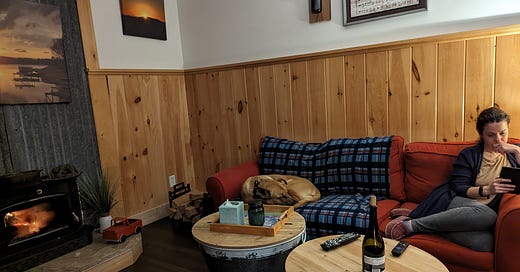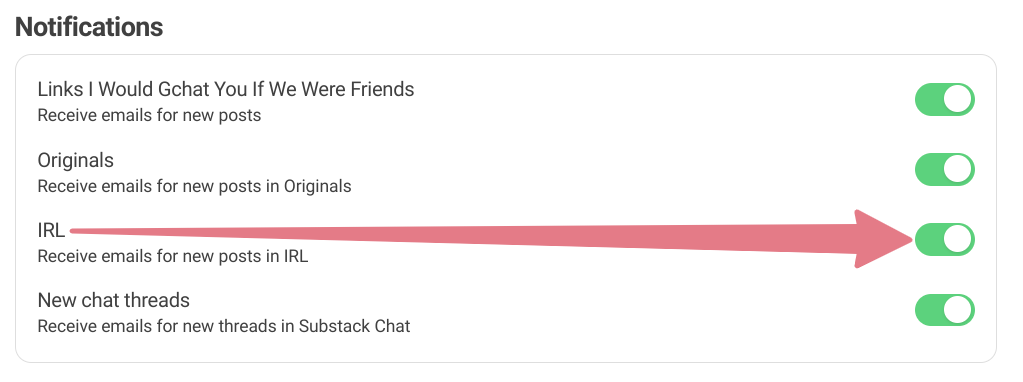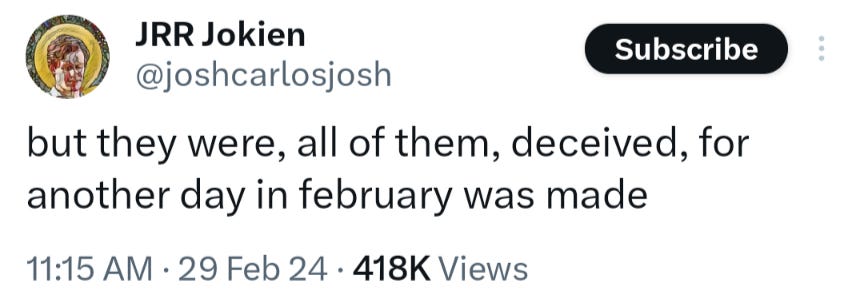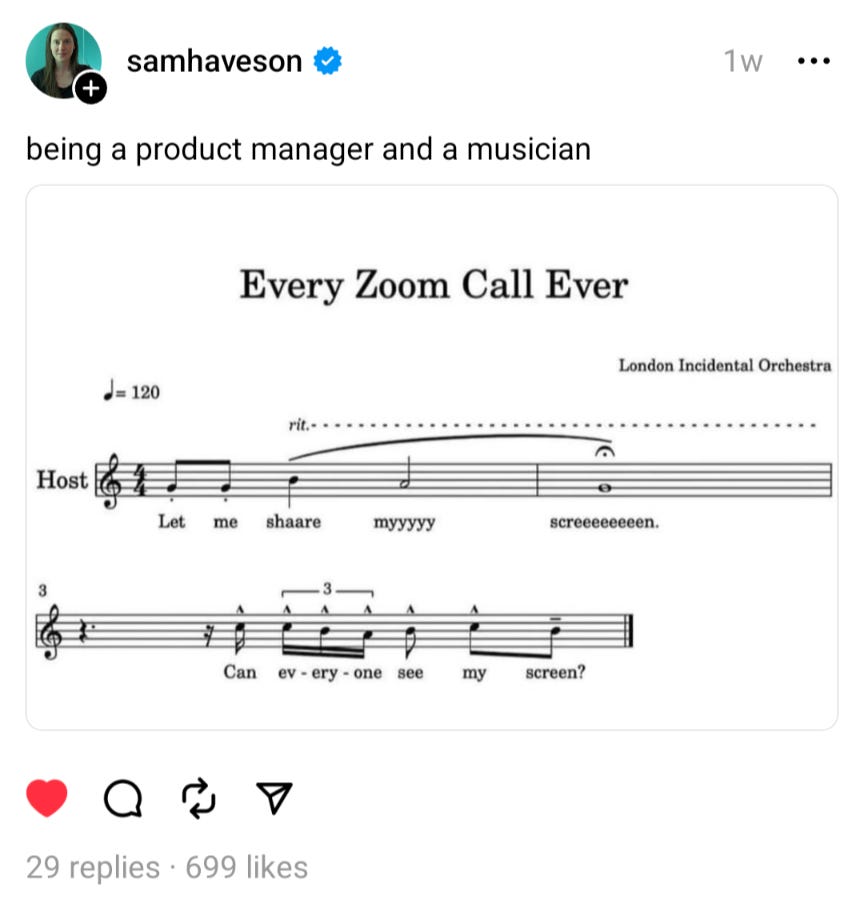Tradwife obsessions, online archnemeses and a requiem for TinyLetter
Plus: Putting the "friend" back in "Links I Would Gchat You If We Were Friends"
Hi friends, and happy Saturday! I’m excited to share a little update with you. Starting the week of March 10, Links is publishing on a new, twice-weekly schedule: You’ll get the opening essay on Tuesday or Wednesday — then your links on the weekend, as usual.
Wait, what’s changing?
First: I’m basically splitting the existing newsletter into two parts. I think we can all admit it was getting pretty long. The top half — an essay, reported article or other piece of original content — will mail during the week. The bottom half, or the link round-up, will send on weekends.
Second: I’m taking advantage of a Substack feature called “sections” to experiment with some new forms of writing. This will be OPT-IN only. You will never receive more than two emails per week from me unless you proactively opt-in yourself. (More on that in just a minute.)
Will the content be different?
On a week-to-week basis, no — I’m just splitting the existing newsletter in two. But I am also going to begin writing very occasionally under an additional, experimental section called IRL, which you will not receive unless you choose to.
What is IRL?
IRL is a, uh … blog. Why dress it up as anything else! I want a space to write more freely without worrying about engagement or conversions or all the other incentives of online publishing, and this is hopefully it. I plan to keep writing about the stuff that makes up my actual, day-to-day life — like quitting my day job or navigating grief — plus other things that feel too personal or off-topic for the main feed.
It’s basically my attempt to put the “friend” back into “Links I Would Gchat You If We Were Friends.” And since I’ve met some of my best friends through this newsletter … IRL feels like a good, needed, natural extension!
Why are you making these changes?
These tweaks grew out of last year’s subscriber survey, interviews with highly engaged readers and my own frustrations with the limitations of the current format. Links began life as a straight curation newsletter, and I’ve stuck with that same basic template since 2014. But lately, I’ve found myself looking for more flexibility.
Also, I’m working to ~optimize~ the overall newsletter before I launch paid subscriptions. They’re still coming!! It’s gonna be great!! Alas, nothing throws a launch schedule like recurring miscarriage. 😬
How do I opt-in to IRL?
Go to http://linksiwouldgchatyou.substack.com/account and toggle the “IRL” button to green, like so. Again, you will only get these occasional extra posts if you opt in.
What if I only want the weekend link round-up?
If you only want to receive the weekend round-up, minus original essays, Q&As and reported articles about internet culture, you can also do that now! Just go to account settings and toggle the “Originals” button to the grey/off position.
What if I have another question?
I am ALWAYS available by email, if … not always in a timely fashion. Substack also just launched DMs, apparently, though I make no promises about that.
If you read anything else this weekend
“How the Pentagon Learned to Use Targeted Ads to Find Its Targets—and Vladimir Putin,” by Byron Tau for Wired. I think the headline on this pieces actually kinda sells it short — it’s the clearest, most terrifying and most essential explanation I’ve ever read for ad-tracking tech, in any form. Ad-tracking data can unmask spies and soldiers; it’s been used to harass people seeking abortion care. And if you’ve ever shared your location with an app, there’s a good chance that “tens of thousands of total strangers” have “a detailed log of your precise movement patterns.” (For more on the horrors of ubiquitous adtech, plz see this week’s Atlantic: “A big part of why the internet has become an adpocalypse is that this kind of targeted advertising is no longer reserved for the tech giants.”)
“Demoted, Deleted, and Denied: There’s More Than Just Shadowbanning on Instagram,” by Natasha Uzcátegui-Liggett and Tomas Apodaca for The Markup. Many people allege foul play in Instagram moderation; Apodaca and Uzcátegui-Liggett actually proved it. The pair carried out a lengthy, in-depth experiment, chronicled here, that demonstrated the myriad ways Meta hides, downplays or limits posts from accounts that mention violent conflicts. For me, this reporting — in combination with Meta’s oft-articulated, apolitical hopes for Threads — paint a pretty alarming vision of a shiny, sanitized, advertiser-friendly online world that looks increasingly unlike the one we actually live in.
“TinyLetter, In Memoriam,” by Kevin Nguyen for The Verge. There are quotes in this essay I plan to print out and stick up on my office wall — not because I loved TinyLetter that much as a tool, but because I loved the ethos of the TinyLetter era. More than a newsletter platform or publishing tool, TinyLetter was a vehicle for a movement of personal, aimless, noncommercialized writing that generally doesn’t exist online anymore. (It’s also — coincidentally!! — the kind of writing I want to do with IRL.)
“How ‘Libs of TikTok’ Became a Powerful Presence in Oklahoma Schools,” by Taylor Lorenz for The Washington Post. Hadn’t planned to include this one; the lengthy discourse around it wore me out. But I clicked “play” on the accompanying YouTube interview, just to understand the fuss, and somehow was still watching 20 minutes later. On an internet drama level, it is fascinating and phenomenal to see two known arch-nemeses confront each other across a cafe table. On a future-of-democracy level, it’s essential to understand the racist, anti-trans ideology that Chaya Raichik successfully peddles to millions of people. And on a journalistic level, I’m sincerely so impressed by Lorenz’s ability to stay friendly and focused and level-headed in the face of … well, herself. Raichik literally wore a T-shirt with Lorenz’s face on it. I would call it trolling, but that connotes it’s not important.
“Meet The Family,” by Chloe Joe for Bustle. I count six named sources in this distillation of family-based internet archetypes, an impressive degree of reporting for a … pretty silly constellation of very online tropes. Or maybe they’re not silly! Maybe, as Joe argues, “daddy” and “mother” and “babygirl” actually tell us something about the ways that women and queer folks, in particular, are processing our current historical moment. (If you like this — or, hell, if you hate it; I’m just here to read about Hot Priest and Pedro Pascal — you might also appreciate Vox’s attempts to explicate the rise of the Irish babygirl.)
👉 ICYMI: The most-clicked link from last week’s newsletter was this piece on “Temu victims” (… mothers).
Postscripts
Flop rock. Lostwave. CollegeHumor v2. The jealous psychology of anti-fans and the sad AI afterlives of local papers. Deepfake porn app ClothOff uncovered. More writing on BookTok queen Sarah Maas, plz. When plus-sized influencers go on Ozempic. Internet comes for Antarctica. That weird Willy Wonka fiasco, explained.
The leading edge of AI is porn. The “shitty vultures” destroying fandom. Pity the viral sourdough retiree and the beleaguered folks receiving seven-minute voice memos. I know I overuse the word “dystopian,” but give me another term to describe the desperate, mercenary, absurd impulses of Amazon influencers. Last but not least: Nara Smith is my tradwife obsession, bar none, and I didn’t even KNOW there was an LDS connection.
Until next week! Warmest virtual regards,
Caitlin







Sooooo excited for IRL! Take me back to 2002.
Absolutely here for the IRL 🫖